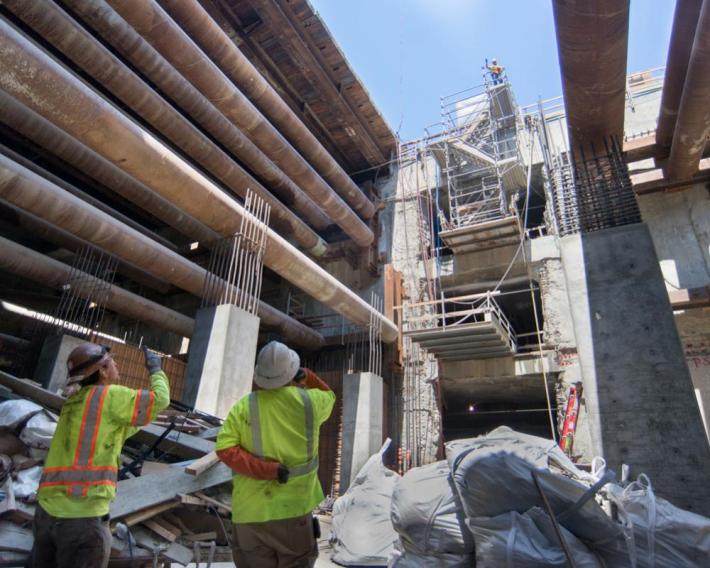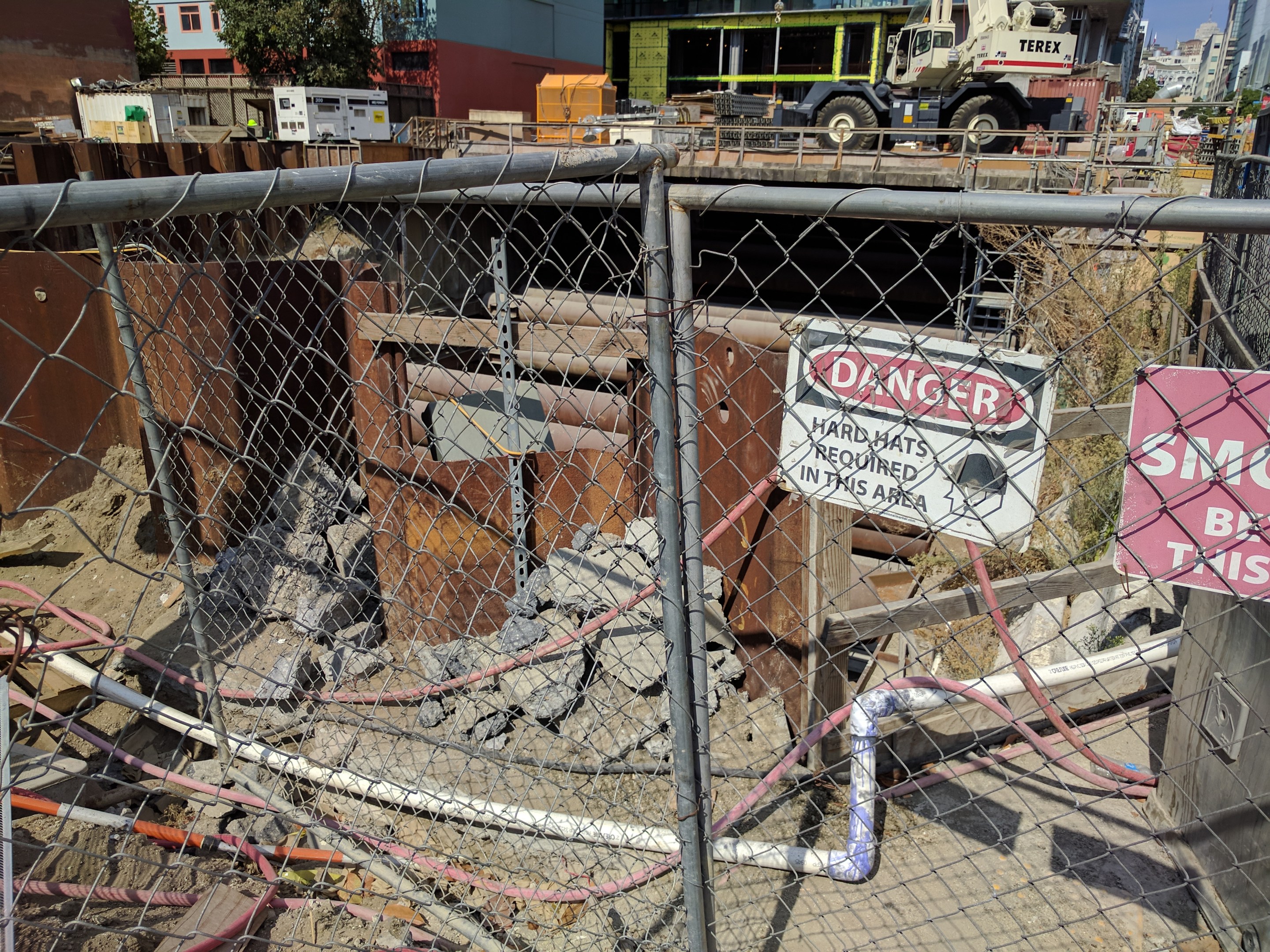Note: GJEL Accident Attorneys regularly sponsors coverage on Streetsblog San Francisco and Streetsblog California. Unless noted in the story, GJEL Accident Attorneys is not consulted for the content or editorial direction of the sponsored content.
John Funghi, it was announced at the end of 2017, was leaving his post heading up the $1.6 billion Central Subway project to work on Caltrain electrification. His departure came shortly after Tutor-Perini, the prime contractor on the Central Subway, a 1.7 mile extension of the Muni T Third line from the Caltrain Station at Fourth and King, to Chinatown, released a report that shows the project is more than two years behind schedule. Trains aren't now supposed to roll to Chinatown until the Spring of 2021, when original projections were for service to start last year.
Just three months ago, SFMTA argued that the project was delayed only nine months and that it was still “within budget.” They blamed the contractor for delays. It now appears that the project, according to the SF Chronicle, is also tens of millions over budget.
All of which is symptomatic of a project that was overly complex, oversold, and badly managed from the start.
It was back in 2007 that the SFMTA began to aggressively sell the Central Subway. In San Francisco, the agency was promoting ridership figures up to 93,000, as reported in the SF Examiner; meanwhile, they were telling the Feds far less. SFMTA’s New Starts Report submitted to the federal government showed the combined 2030 ridership of the subway and the existing T Line as being only 64,620 riders a day, with the subway itself generating 42,400 riders a day (Source EIR Table 3-9). The agency claimed trip times would be drastically cut, but improvements to the Stockton Street bus could have reduced trip times from Chinatown to Market Street and Caltrain for a tiny fraction of the cost. Operating costs were also far higher than the agency originally presented (in fact, they originally argued that it would cut operating costs).
Then there's the question as to why the SFMTA only looked at using an expensive and complex deep-bore subway, which means tunneling deep underground and necessitates the construction of giant underground station mezzanines and huge holes, such as in the lead image and the photo near the bottom. The promise was that deep-tunnel boring would be out of sight and would avoid disruption to local businesses and residents. But that didn't materialize. In fact, the city is now on the hook to compensate businesses along the route from the very disruptions that deep-bore subway digging was supposed to avoid.
Cut-and-cover construction, in which the city cuts a trench in the street and then covers it up (which is how the New York subway and many subways overseas were built) plus more of the line running on the surface, could have made for a much simpler design. There is even room to run trains in a shallow subway where it crossed Market Street, in the space between BART and the Muni tunnels, instead of diving deep underneath both train systems. The train also could have run farther on the surface on 4th street, instead of going underground at Bryant. But none of these options were looked at in the original, legally mandated alternatives analysis, which studied some zigzag routes that were obviously designed to be rejected in favor of the current design. In other words, the Central Subway was designed in a backroom deal, without an appropriate alternatives analysis as assigned by California law. The priority was apparently to avoid losing any surface street to automobiles.
But even the overly complex design doesn't explain the extent of the delays.
On November 1, 2017, Tutor-Perini, the Central Subway construction contractor, asked San Francisco Supervisor Aaron Peskin, Chair of the San Francisco County Transportation Authority, to help resolve the hundreds of outstanding issues between it and the SFMTA. Because of the lack of details in the designs, the construction contractor issued over 4,000 "requests for information." That can be something very simple--for example, the plans might say, "Use a tile floor covering" on the mezzanines. And the contractor might ask, "Do you want granite or marble?" Some of the issues are far more complicated and expensive, but in any case, they have to be resolved in days or weeks, not months, or the project spins out of control.
But SFMTA let a backlog of information requests develop. The delays started to cost the contractor money, so they also filed claims for additional funds--then these got delayed too. Out of 1,300 construction-contractor claims filed, only 73 had been addressed by the SFMTA, with the remaining 94 percent “waiting to be processed.” The contractor also reported that the project is 29 months behind schedule, compared to the SFMTA’s claim of only nine months of delay.

As someone who has worked on large construction projects, it's not unusual for there to be claims for additional compensation. To continue the tile example, if the SFMTA specifies a more expensive type of tile, or delays answering a question for so long the prime contractor has to pay workers to sit around and wait--then the prime contractor requests compensation for the additional costs. The problem is, it's essential to respond to these claims immediately by paying or rejecting them. But SFMTA doesn't have experienced staff to make decisions on the spot. Delays pile up the costs because contractors lose subcontractors who have to move on to other construction gigs. On a badly managed project, especially huge ones with thousands of claims and requests for information, minor delays quickly snowball.
When a project such as the Central Subway turns sour, municipal agencies sometimes try to blame the construction contractor. True, when a contractor submits a false or inflated or unjustified claim, alert owners summarily reject it, as they should. When, on the other hand, owners, meaning the SFMTA, make design mistakes or otherwise cause construction delays and overruns by dithering and sloppiness, it then ends up in court: judges will almost always place the responsibility for the resulting extra costs squarely on the owner, as they should.
And in this case, ultimately, that means the taxpayer.
The lessons here are to keep projects simple, do an alternatives analysis of proper, viable alternatives with realistic outcomes and projections, and get qualified staff in place to properly manage the project in detail, right on site. Qualified staff means people who are capable of making decisions and getting claims sorted quickly and definitively. Right now, managers and directors dither, let delays and cost overruns get out of control, and then they move on to new agencies and projects, leaving the taxpayers to clean up the mess. Until San Francisco solves these problems, we can kiss any vision of a greatly expanded transit system goodbye.
Gerald Cauthen is co-founder of the Bay Area Transportation Working Group and SaveMuni. He has managed the design and construction of Muni, San Francisco Water Department and Hetch Hetchy infrastructure projects.





